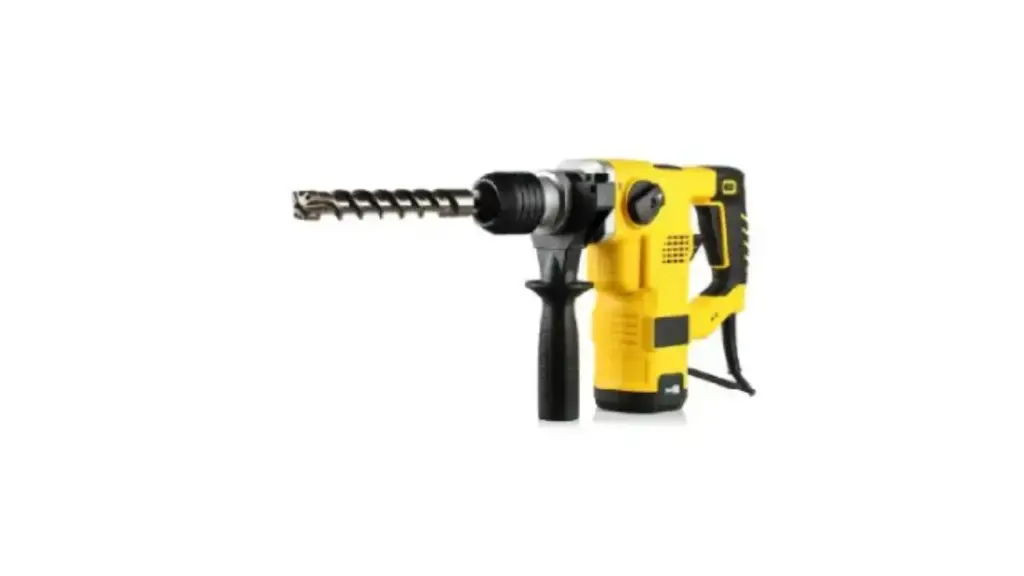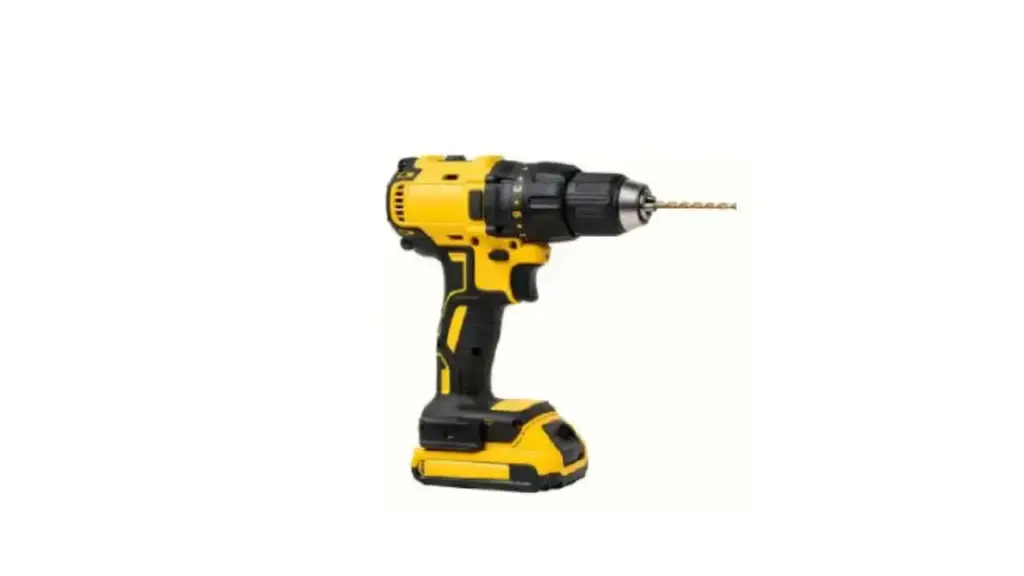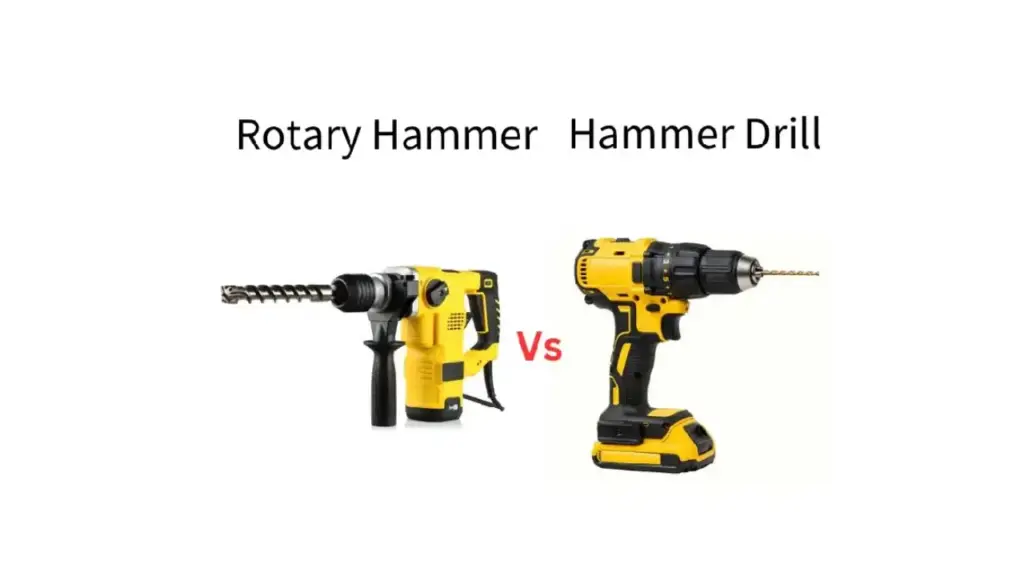Ever wondered about the difference between a rotary hammer and a hammer drill? While they both make holes, they tackle tough materials in distinct ways. One uses forceful hammering, while the other combines rotation with powerful pulses.
Choosing the right tool for your project is crucial. Understanding their unique mechanisms and capabilities will save you time and effort, ensuring you get the job done efficiently and effectively. Let’s dive in and explore their key differences!
What is Rotary Hammer

A rotary hammer is a powerful power tool designed for heavy-duty drilling and chiseling in hard materials like concrete, brick, and stone. Unlike a standard drill or even a hammer drill, a rotary hammer uses a piston-driven mechanism to generate a strong hammering force directly on the drill bit, independent of the rotational force.
This electro-pneumatic or mechanical hammering action, combined with rotation, allows it to quickly and efficiently bore through tough materials and perform tasks like breaking concrete or removing tiles when used with chisel bits.
Key Features of Rotary Hammers
Rotary hammers stand out in the power tool arena due to their specialized features designed for tackling tough materials. Understanding these key aspects will help you appreciate their capabilities and choose the right model for your needs.
Let’s delve into what makes these tools so effective for heavy-duty drilling and demolition tasks.
Multiple Operating Modes
Rotary hammers typically feature three distinct modes to cater to various applications. Rotation with Hammer delivers powerful drilling in concrete and masonry. Hammer Only mode transforms the tool into a demolition hammer for chiseling and breaking. Some models also offer Rotation Only for drilling softer materials like wood or metal with standard drill bits.
SDS Chuck System
The Special Direct System (SDS) chuck is a key feature, enabling rapid and secure bit changes. This system is specifically engineered to withstand the intense impact forces generated by the rotary hammer’s hammering action. The SDS design ensures optimal power transfer from the tool to the bit, maximizing efficiency and prolonging the lifespan of both the tool and the bits.
SDS Plus and SDS Max
Two primary SDS variations exist: SDS Plus and the more robust SDS Max. SDS Plus rotary hammers are lighter and better suited for smaller projects. SDS Max models deliver greater power and are ideal for demanding, heavy-duty tasks in tougher materials. The shank diameters also differ, with SDS Plus bits measuring 10mm and SDS Max bits featuring an 18mm shank.
Power and Impact Energy
A crucial specification for rotary hammers is their impact energy, measured in joules. A higher joule rating signifies a more forceful hammering action, directly correlating to the tool’s ability to penetrate dense materials. Professional-grade rotary hammers can boast impact energy exceeding 10 joules, making them capable of handling the most challenging demolition and drilling jobs.
Corded and Cordless Options
Rotary hammers are available in both corded and cordless configurations. Corded models offer consistent, unwavering power, making them suitable for extended use on job sites with easy access to power outlets. Cordless versions provide enhanced mobility and convenience, although runtime is dependent on battery capacity. Advancements in battery technology are continually improving the power and performance of cordless rotary hammers.
What is a Hammer Drill

A hammer drill is a versatile power tool that combines a standard rotary drilling action with a percussive hammering motion to effectively drill into harder materials like brick, block, and concrete. It achieves this hammering action through a mechanical clutch mechanism that causes the drill bit to rapidly tap forward as it rotates.
While not as powerful as a dedicated rotary hammer, a hammer drill provides sufficient force for drilling smaller diameter holes and tackling lighter masonry tasks, making it a useful tool for both DIYers and professionals needing a multi-purpose drilling solution.
Key Features of Hammer Drill

Hammer drills are indispensable tools for a variety of drilling tasks, offering a blend of standard drilling capabilities and a percussive hammering action. Their key features contribute to their versatility and ease of use across different materials and applications. Understanding these features is crucial for selecting the right tool for your specific needs.
Dual Modes
Most hammer drills come equipped with dual operational modes. The Regular Drilling mode functions like a standard drill, ideal for materials such as wood and metal. Switching to Hammer Drilling mode engages a hammering action alongside rotation, enabling effective drilling into masonry materials like brick and concrete, offering versatility in one tool.
Standard Chuck
Typically, hammer drills feature a standard chuck mechanism. This design allows compatibility with a wide array of regular drill bits available in the market. This flexibility makes hammer drills suitable for diverse drilling tasks beyond just masonry. Some newer models incorporate keyless chucks, simplifying and speeding up the process of changing bits.
Speed and Power
The performance of a hammer drill is often indicated by its rotational speed (RPM) and impact rate (IPM). Higher RPM values facilitate faster drilling in softer materials. Conversely, a higher IPM suggests a more effective hammering action for tougher materials. Certain professional models can achieve impressive impact rates exceeding 50,000 impacts per minute for demanding applications.
Corded and Cordless Options
Hammer drills are available in both corded and cordless configurations. Corded models offer continuous power, making them well-suited for prolonged and intensive use. Cordless options provide enhanced mobility and convenience, powered by batteries. Modern cordless hammer drills often utilize lithium-ion technology, known for its extended runtime and quicker recharging capabilities.
Rotary Hammer vs Hammer Drill
Choosing between a rotary hammer and a hammer drill depends on the task at hand. Both offer drilling capabilities in masonry, but their mechanisms and power differ significantly. Understanding these distinctions ensures you select the most efficient and appropriate tool for your specific needs, saving time and effort on the job site or during home renovations.
Power Mechanism
Rotary hammers generate their powerful hammering action through an electro-pneumatic or mechanical piston system. This direct, forceful impact is independent of the drill’s rotation, allowing it to pulverize hard materials like concrete with ease. The strong percussive force combined with rotation enables quick and efficient drilling of larger diameter holes and effective chiseling.
Hammer drills utilize a mechanical clutch system to create a hammering effect. As the drill bit rotates, the clutch causes it to rapidly tap forward. This percussive action assists in drilling through materials like brick and block. However, the hammering force is less powerful compared to a rotary hammer, making it more suitable for smaller holes and lighter masonry work.
Drilling Capacity
Due to their robust hammering mechanism, rotary hammers excel at drilling larger diameter holes in dense materials such as reinforced concrete and hard stone. They are designed to handle demanding tasks requiring significant material removal. Their efficiency in drilling large holes quickly makes them indispensable for heavy construction and demolition work.
Hammer drills are generally more effective for drilling smaller to medium-sized holes in softer masonry materials like brick, block, and less dense concrete. While they can drill larger holes, it typically requires more time and effort compared to a rotary hammer. Their capacity is well-suited for tasks like installing anchors, setting screws in masonry, and general construction where smaller holes are common.
Chiseling Functionality
Rotary hammers often feature a dedicated chiseling mode, where the rotation stops and only the powerful hammering action is engaged. This makes them ideal for tasks like breaking concrete, chipping away tiles, and demolition work. The strong, direct impact delivered by the piston mechanism ensures efficient material removal.
While some higher-end hammer drills may offer a chiseling function, it is generally less powerful and less efficient than that of a rotary hammer. They can handle light chiseling tasks, such as removing small amounts of mortar or shaping softer materials, but are not designed for heavy demolition or extensive material removal.
Vibration and User Fatigue
The powerful hammering action of rotary hammers can generate significant vibration. However, many modern rotary hammers incorporate anti-vibration technologies to mitigate this, enhancing user comfort during prolonged use. Their efficiency in heavy-duty tasks can also lead to quicker completion, potentially reducing overall fatigue.
Hammer drills typically produce less vibration than rotary hammers due to their less forceful hammering mechanism. This can make them more comfortable for extended use, especially for lighter drilling tasks. However, struggling to drill larger holes in hard materials with a less powerful tool can also lead to user fatigue.
Here is the table showing you the differences between rotary hammer and hammer drill in the following:
| Feature | Rotary Hammer | Hammer Drill |
| Power Mechanism | Electro-pneumatic/Mechanical piston | Mechanical clutch |
| Hammering Force | Strong, independent of rotation | Less powerful, combined with rotation |
| Drilling Capacity | Large diameter holes in hard materials | Small to medium holes in softer masonry |
| Chiseling | Dedicated mode, powerful and efficient | Limited capability, less powerful |
| Vibration | Higher, often with anti-vibration technology | Lower |
| Typical Use | Heavy-duty concrete, demolition, large holes | Lighter masonry, smaller holes, general tasks |
How to Choose Rotary Hammer and Hammer Drill
Selecting the right tool hinges on the primary applications you anticipate. For frequent, heavy-duty tasks like drilling large diameter holes in concrete, breaking concrete, or extensive chiseling, a rotary hammer is the clear choice.
Its powerful piston mechanism delivers the necessary impact energy and durability for demanding jobs. Consider the size and frequency of your projects to determine the appropriate power and features, such as variable speed and vibration control, for optimal performance and user comfort during prolonged use.
For occasional drilling in softer masonry like brick or block, installing anchors, or light chiseling tasks, a hammer drill offers a more versatile and often more affordable option. Its dual functionality as a standard drill makes it suitable for a wider range of household and light professional tasks. Evaluate the maximum drilling diameter you’ll typically require and prioritize features like adjustable depth stops and multiple drilling modes to enhance precision and adaptability for various projects around the home or on lighter job sites.
Consider these key factors when choosing:
- Material Hardness and Hole Size: If you consistently work with hard concrete or need to drill large diameter holes, prioritize the superior impact energy of a rotary hammer. Hammer drills are better suited for softer materials and smaller hole diameters for tasks like installing fixtures or running wiring.
- Frequency and Intensity of Use: For daily, demanding applications like concrete demolition or drilling numerous large holes, invest in a robust rotary hammer built for durability. If your needs are occasional and involve lighter tasks, a less powerful and potentially more compact hammer drill might suffice.
- Budget and Versatility: Hammer drills often come at a lower price point and offer dual functionality for drilling in wood, metal, and masonry. Rotary hammers are typically more expensive but provide specialized power for heavy-duty concrete work. Assess whether the added power is worth the investment for your typical projects.
- Features and Ergonomics: Look for features that enhance usability and reduce fatigue, such as vibration control, variable speed settings, and comfortable grip designs. The weight and balance of the tool can also significantly impact handling, especially during extended use.
Conclusion
In conclusion, the primary distinction between rotary hammers and hammer drills lies in their power mechanism. Rotary hammers utilize a piston for forceful hammering, excelling in tough materials and larger holes. Hammer drills employ a clutch mechanism for lighter hammering, suitable for smaller tasks in softer masonry.
Choosing the right tool depends on the project’s demands. For heavy-duty concrete work, a rotary hammer is essential. For lighter tasks in brick or block, a hammer drill suffices.
For those seeking reliable and high-quality drilling tools for various applications, including heavy-duty tasks, consider sourcing your wholesale needs from Sinodrills.


